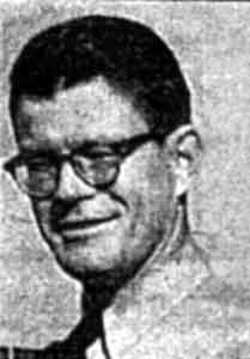
LAKE COUNTY, Calif. – A motorcade bearing the remains of a North Coast Korean War soldier identified and returned to US officials in April after being missing for nearly 70 years will pass through Lake County on Monday.
Officials are transporting the remains of Army Sgt. 1st Class Elden C. Justus along Interstate 5 to Highway 20 en route to his final resting place in Arcata, where burial will take place on July 11.
The Lake County Sheriff’s Office said the motorcade is expected to reach Clearlake Oaks between 4 to 4:30 p.m. on Monday, July 8.
Lake County Sheriff’s deputies will join other law enforcement agencies from throughout the county to honor Justus, and the public is welcome to join them in honoring the fallen soldier as his motorcade travels through Lake County.
The Military Funeral Honors Team also will be on hand, stationed in Upper Lake across from Judy’s Junction restaurant, and will conduct a 21-gun volley in Justus’ honor.
Justus’ homecoming comes 69 years after he was reported missing in action.
Justus was killed near Hagaru-ri in North Korea on Dec. 6, 1950, according to a June obituary published in the Eureka Times-Standard. “He was last seen directing his men in repulsing an enemy attack while covering for the withdrawal of American troops from the battlefield.”
Initially, when he disappeared, it wasn’t known whether he had been killed according to his first obituary, published in the Eureka Times-Standard in January 1954.
The Defense POW/MIA Accounting Agency, or DPAA, said Justus’ remains were accounted for on April 16 after being recovered from a communal gravesite in North Korea 15 years ago.
Justus was born in New Mexico and raised in Arcata, graduating from Arcata High School. He enlisted in the Army in 1945, serving four years in Germany before being sent to Korea, according to his 1954 obituary.
In late November 1950, Justus, 23, was a member of Headquarters Battery, 57th Field Artillery Battalion, 7th Infantry Division, the DPAA said.
At that time, 2,500 U.S. and 700 South Korean soldiers assembled into the 31st Regimental Combat Team, which was deployed east of the Chosin Reservoir, North Korea, when it was engaged by overwhelming numbers of Chinese forces, according to the DPAA report.
By Dec. 6, the U.S. Army evacuated approximately 1,500 wounded service members; the remaining soldiers had been either captured or killed in enemy territory, officials said.
When Justus could not be accounted for by his unit at the end of the battle, the DPAA said he was reported missing in action as of Dec. 6, 1950.
His January 1954 obituary said Justus was declared dead by the U.S. Army as of Dec. 31, 1953.
Work that began decades later would lead to the eventual recovery and identification of Justus’ remains.
From April 28 to May 10, 2004, the Joint POW/MIA Accounting Command, a predecessor to DPAA, conducted joint recovery operations with the North Korean People’s Army in the vicinity of the Chosin River, officials said.
DPAA said the recovery team excavated two sites, recovering the remains of at least five individuals.
The Democratic People’s Republic of Korea, or North Korea, unilaterally turned over the remains to the UNC Military Armistice Commission, where they were subsequently accessioned to the laboratory, the DPAA said.
In order to identify Justus’ remains, scientists from DPAA used dental and anthropological analysis, as well as material evidence. Additionally, scientists from the Armed Forces DNA Identification Laboratory used mitochondrial DNA and autosomal DNA analysis.
At the time of his death, Justus left behind a wife, Ruth; children, Jack and Lois; his mother, Lois Childs; and his sister, Edna Smith. Today, his survivors include his adult children, grandchildren and great-grandchildren.
After his remains arrive in Arcata on Monday, they will lie in honor at Paul's Chapel for public visitation on July 9 and 10. His funeral will take place at 11 a.m. July 11 at the Eureka Elks Lodge, and he will be interred at the Greenwood Cemetery in Arcata.
While the search for Justus has now reached its conclusion, the DPAA said 7,652 Americans still remain unaccounted for from the Korean War.
Using modern technology, identifications continue to be made from remains that were previously returned by Korean officials, recovered from Korea by American recovery teams or disinterred from unknown graves, officials said.
Justus’ name is recorded on the Courts of the Missing at the National Memorial Cemetery of the Pacific, in Honolulu, along with the others who are missing from the Korean War, according to the DPAA report.
The DPAA said a rosette will be placed next to his name to indicate he has been accounted for.
Email Elizabeth Larson at

 How to resolve AdBlock issue?
How to resolve AdBlock issue? 



